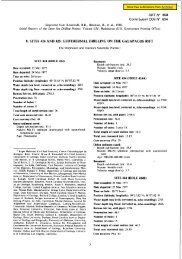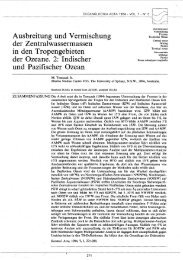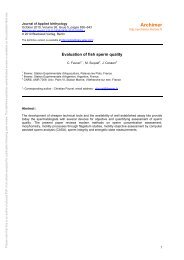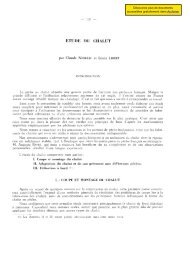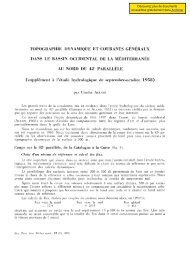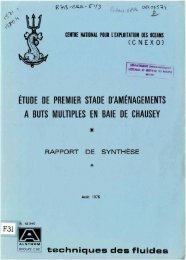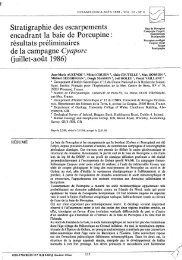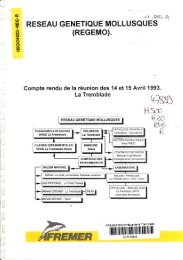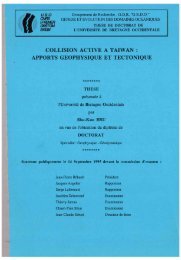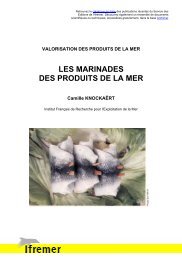Contribution à l'étude de virus de mollusques marins apparentés ...
Contribution à l'étude de virus de mollusques marins apparentés ...
Contribution à l'étude de virus de mollusques marins apparentés ...
Create successful ePaper yourself
Turn your PDF publications into a flip-book with our unique Google optimized e-Paper software.
PUBLICATION 3<br />
Bull. Eur. Ass. Fish Palhal. 14(2),64, 1994.<br />
HERPES-LIKE VIRUS INFECTING JAPANESE OYSTER<br />
(CRASSOSTREA GIGAS) SPAT<br />
Bv T. RENAULT, N. CaCHENNEC, R. M. L E<br />
DEUFF AND B. C Ha LLET<br />
Introduction<br />
During the summer of 1993, abnormal sporadie<br />
mass morta lities (80-90%) and morbidities<br />
occurred among four batches of<br />
young Japanese oyster (Crassostl'ea gigas)<br />
spat fro m the French Atlantic coast. These<br />
mortalities were only observed in July.<br />
Samples of affected animais were examined<br />
by electron microscopy. This paper reports<br />
the presence and appearance of herpes <strong>virus</strong>es<br />
in these samples.<br />
Matel'ial and Met/lOds<br />
Samples of cultured 3-7 month-old oyster<br />
spat were collected on the French Atlantic<br />
coast. These spat were survivors of populations<br />
in which mortalities of 80-90% had<br />
occurred.<br />
For light microscopy, oysters were fixed in<br />
Davidson's fluid . For transmission electron<br />
microscopy, tissue pieces were fi xed for Iii<br />
in cold 2.5% glutaral<strong>de</strong>hy<strong>de</strong> in cacodylate<br />
buffer and post-fixed in 1 % osmium<br />
tetI'Dxi<strong>de</strong> in the sa me buffer. Tissues embed<strong>de</strong>d<br />
in Epon were eut on a LKB uhramicrotome<br />
and we re stained with uranyl acetalc<br />
and lead citrate, and examined with a<br />
J EOL JEM 1200 EX transmission electron<br />
microscope at 60 kV.<br />
Results and Discussion<br />
The main histological changes in the diseased<br />
spat consisted essentially of the presence<br />
of enlarged nuclei that showed abnormal<br />
shape and abnormal chromatin pattern<br />
throughout the connective tissue in the gills,<br />
the mantle and around the digestive tubules.<br />
The inflammatory reaction in these areas<br />
was reduced.<br />
By electron microscopy interstitial cells of<br />
gills and man tle exhi bited intranuclear and<br />
74<br />
intracytoplasmic <strong>virus</strong>-like particles. In infected<br />
cells, the nueleus contained spherical<br />
or polygonal particles, 80 nm in diameter<br />
(Fig. 1). Some partieles appeared empty and<br />
consi sted of structures assumed to be capsids<br />
(Fig. 2), others contained an electron-<strong>de</strong>nse<br />
core and were interpreted as being<br />
nueleocapsids (Fig. 2). Unenveloped<br />
particles were observed in the cytoplasm of<br />
myocytes in the mantle connective tissue<br />
(Fig. 3). Enveloped single virions were observed<br />
in cytoplasmic vesicles into others<br />
cells (Fig. 4). In cytolytic cells and in extracellular<br />
spaces. enveloped <strong>virus</strong>es were also<br />
seen (Fig. 5). These partieles consisted of a<br />
caps id with an elec tron-<strong>de</strong>nse core that was<br />
in tum surroun<strong>de</strong>d by a unit-membrane like<br />
structure (Fig. 6). Envelope and caps id were<br />
separated by a reduced electron-Iucent gap.<br />
Fine filaments passed from the toroidal core<br />
to the insi<strong>de</strong> of the caps id (Fig. 6). The enveloped<br />
partieles had spike-li ke protrusions<br />
on the surface.<br />
Ultrastructural changes were found to be<br />
related to the presence of the <strong>virus</strong> in the<br />
oyster spat. Abnorrnal accumulations of<br />
granular endoplasmic reticulum associated<br />
with swollen mitochondria (Fig. 7) and<br />
con<strong>de</strong>nsed nuclei with electron-Iucent centre<br />
(Fig. 1) were often observed. Degenerating<br />
and Iysing infected nuclei were frequently<br />
present too.<br />
The virions <strong>de</strong>scribed resemble herpes <strong>virus</strong>es<br />
in morpholog ical characteristics, in<br />
cellular locations and in size range<br />
(Roizman et al., 198 1; Murphy and<br />
Kingsbury, 1990; Roizman, 1990). In addition,<br />
the fibril s spanning the space from the<br />
core to the inner surface of the capsid are<br />
similar to the arrangement in herpes <strong>virus</strong>es<br />
(Furlong et al., 1972; Roizman, 1990). It<br />
seems capsids and nueleocapsids are forrned<br />
in the nucleus and then pass through the<br />
nuclear membranes inta the cytoplasm.



